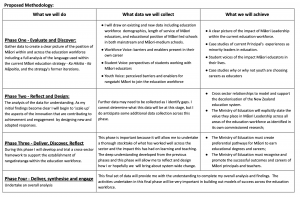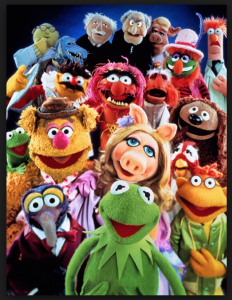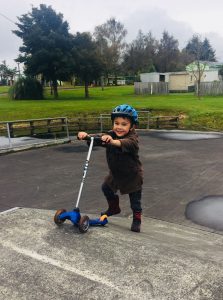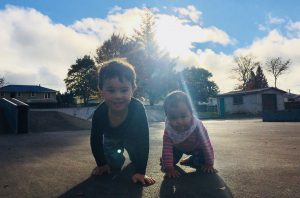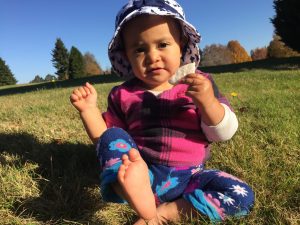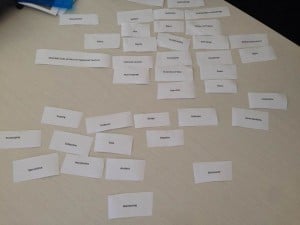The project brief is a preliminary description of the project you wish to complete as part of the programme. The purpose of the Project Brief is to provide a short summary of your proposed project and make a preliminary argument for why the project is desirable.
Learning outcomes for this assessment include:
-
Analyse and critique key literature relating to the organisational needs of the Māori sector.
-
Critically review theories and analyse strategies and approaches related to leading culturally responsive change in the Māori sector.
-
Explore assumptions and mental models that underline leadership roles and organisational structures in order to critically reflect on enablers and barriers to change.
-
Explore the political dynamics infusing Māori and Indigenous organisations.
My assignment:
The aim of this project is to decolonise the New Zealand education system through the following actions:
- The Ministry of Education must explicitly affirm the value of Māori Leadership across all areas of the education workforce as identified in its own commissioned research;
- The Ministry of Education must create preferential pathways for Māori to earn educational degrees and careers;
- The Ministry of Education must recognise and promote existing successful outcomes and careers of Māori principals and teachers.
Introduction – We Are Not OK:
The publication, the Hunn Report (1961), formally illustrated the global disadvantage of Māori within contemporary New Zealand society. This disadvantage is still prevalent within Māori society 62 years later with 2019 data showing that over a third of Māori leave school without Level Two NCEA. Retention rates for Māori are 12% lower than tauiwi (non-Māori). Term Two 2020 attendance rates for Māori dropped to 47.5%, 21.2% behind European students.
The “statistical blackhole” of Māori engaging in higher education (Hunn, 1961) has been corrected, however the picture it paints is bleak. In terms of attainment Māori continue to lag behind non-Māori in tertiary education qualifications.

The negative effects of low tertiary outcomes are clearly detailed in Nair and Smart’s 2007 report to the Ministry of Education. Those without a formal education qualification are ten times more likely to suffer from severe hardship in their living conditions as compared to those with a Bachelors level or higher qualification. The report concludes that the return on investment in tertiary education is significant on employment, income and improved health and lifestyle outcomes (Nair et al., 2007). All are areas where Māori feature significantly at the lower end of the statistics. Yet the latest data still illustrates the continued failings of the New Zealand education system to provide equitable outcomes for Māori (Jackson, 2016).
Tertiary Level Equivalent Full Time Students in 2019
Bachelors Degrees and higher
Total Students Enrolled – 167 840
European Students Enrolled – 92 205
Māori Students Enrolled – 18 360
Why Leadership Counts and Why Māori Leadership is Transformative:
Wagner and Kegan (2006) explain that our education system was not designed for the skills needed in today’s society. They propose that a new form of leadership is needed that grows the personal capacities of all members of an organisation. In fact they often refer to the leadership structures needed to transform our schools as leadership communities. Within these communities the leader becomes the mediator that encourages growth and new opportunities for learning, even when there are contradictions evident in the communities thinking (Wagner et al., 2006). The new transformational leadership model shifts away from the traditional capitalist model of leadership which priorities power and control (Wagner et al., 2006).
School Leadership and Student Outcomes: What Works and Why: Best Evidence Synthesis [BES] (Robinson et al., 2009) is a significant document which seeks to test the notion that “school leaders make a critical difference to the quality of schools and the education of young people” (Robinson et al., 2009, p.48). This Ministry of Education document indeed makes this connection between leadership and successful outcomes, and it also specifically differentiates Leadership from Māori Leadership and in fact goes one step further by differentiating Māori educational leadership from Māori-medium educational leadership. This is important because it identifies two distinct concepts:
- That Māori leadership is present and important within both the mainstream and Māori-medium educational settings – a point completely absent from all iterations of the Māori education strategy.
- Those tumuki (Principals) in Māori educational leadership positions and Māori-medium educational leadership positions have a disproportionately higher workload than their contemporaries due to the cultural and societal needs of their communities (Robinson et al., 2009, p. 70).
The qualities, skills, and priorities of transformational leadership described in Wagner and Kegan (2006) are imbued throughout Māori history both in pre and post colonial time periods. Katene (2010) states that the primary characteristic of good leadership is vision and the ability to bring one’s community along with that vision. The talents listed by Katene (2010), and synthesised by Mead (2006) to incorporate traditional values within the modern world are all mirrored in Wagner and Kegan’s book. Mead’s (2006) eight Māori leadership talents for today are also found within the five leadership dimensions found in the BES (Robinson et al., 2009, p.95). The research is clear that to be a Māori Leader is to be a transformational leader, the leader needed in today’s society.
An analysis of the Ministry of Education’s Māori Education Strategy:
The Māori education strategy (1999) has had three redevelopments since its launch in 1999. Through these developments it is interesting to analyse the evolution of the language used; in particular the use or non-use of the terms “authority” and its Māori equivalent “rangatiratanga”. These terms are important as described in the Waitangi Tribunal’s Te Whānau o Waipareira Report (1998).
Partnership thus serves to describe a relationship where one party is not subordinate to the other but where each must respect the other’s status and authority in all walks of life (The Waitangi Tribunal, 1998, p. xxvi).
This is reflected in the 1999 publication of the Māori education strategy
“To support greater Māori involvement and authority in education” (The Ministry of Education, n.d.).
The analysis of the evolution of the strategy into its current form Ka Hikitia – Ka Hāpaitia is fascinating as the term “authority” completely disappeared from two of the three rewrites. Most concerningly with in all three of the documents the terms ‘Māori Learners”, “Māori pedagogy”, “te ao Māori”, “Māori medium“, and ”whānau“ are all used to differentiated the diversity of the needs of Māori. The term “Māori Leadership” does not exist within the Ministry of Education’s premier Māori education strategy.
One must question why the Ministry of Education is unwilling to state outright that Māori Leadership is the transformational form of leadership needed to meet the needs of all learners in today’s society. The fact that the Ministry of Education commissioned the research which confirmed this as fact (Robinson et al., 2009) demands explanation.
Ka pū te ruha, ka hao te rangatahi – Cast the old net aside … :
Models of tauiwi organisations adopting Māori governance and leadership structures can be found throughout the New Zealand business landscape. Companies such as CORE Education Tātai Aho Rau have completely rebranded and created the successful Te Aho Tapu, Tiriti Honouring work programme to actively demonstrate their commitment to partnership and Te Tiriti o Waitangi. This is a private company which has built Māori Leadership into the fabric of their leadership and governance structures.
The Otago School of Medicine has enacted the successful “Mirror on Society” enrolment policy creating pathways into medical careers that were once unattainable by Māori unfairly disadvantaged by the effects of institutional racism (Jackson, 2016). The programme is built on the well documented benefits to society of having a socio demographically diverse health workforce as they will lead to better health outcomes for diverse populations such as Māori (Crampton et al., 2018).
These are just two examples of how Māori Leadership and diversity of workforce which must be recognised, supported, and actively recruited as change agents. The steps to replicate these policies and outcomes within the education workforce are not difficult.
The aim of this project is to correct the under representation of Māori in the Education workforce which will in turn enable Ka Hikitia – Ka Hāpaiti’s (2020) first key measure of success “Māori learners are engaged and achieving excellent education outcomes” (The Ministry of Education, 2020).
What is Good For Māori, is Good for All – Dr. Russell Bishop:
Moana Jackson (2016) states that “The education system still continues to fail so many of our mokopuna because that’s what it was designed to do” (Jackson, 2016, p. 41). The Ministry of Education’s continuous attempts to change the people within (the system), to create achievement for the people without, must be recognised as flawed. The overwhelming evidence of Māori Leadership success must be acknowledged, and built upon for the benefit of all learners in today’s society.
The aim of this project is simple, it is the acknowledgement and implementation of research that has existed for years. When The Ministry of Education officially acknowledges and places value on Māori Leadership they will be able to create preferential pathways for Māori into the education workforce through tertiary qualifications. The proven return on investment of a tertiary education will in turn create a forward momentum of positive outcomes for Māori. The entrenchment of Māori rangatiratanga within the framework of the New Zealand education system will reverse the cycle of poverty and hardship within one generation if those in control of the system, The Ministry of Education, are truly committed to their 30 year vision for education:
Whakamaua te pae tata kia tina – Take hold of your potential so it becomes your reality …
We are descendants of explorers, discoverers and innovators who used their knowledge to traverse distant horizons.
Our learning will be inclusive, equitable and connected so we progress and achieve advances for our people and their future journeys and encounters
Whāia te pae tawhiti kia tata – Explore beyond the distant horizon and draw it near!
(The Ministry of Education, 2020)
Bibliography
Crampton, P., Weaver, N., & Howard, A. (2018). Holding a mirror to society? Progression towards achieving better sociodemographic representation among the University of Otago’s health professional students. New Zealand Medical Association Journal, 131(1476), 59 – 69. https://www.nzma.org.nz/journal-articles/holding-a-mirror-to-society-the-sociodemographic-characteristics-of-the-university-of-otagos-health-professional-students
Hunn, J. K. (1961). Report on Department of Māori Affairs: With statistical supplement, 24 August 1960. Wellington: Government Press.
Jackson, M. (2016) Reclaiming Māori Education. In Hutchings, J., & Lee-Morgan, J. (Eds.), Decolonisation in Aotearoa: Education, Research and Practice (pp. 19 – 39). NZCER Press.
Katene, S. (2010). Modelling Māori leadership: What makes for good leadership? MAI Review, 2010(2), 1 – 16. http://www.review.mai.ac.nz/mrindex/MR/article/view/334.html
Mead, H. M.,(2006). Hui Taumata Leadership in Governance Scoping Paper. Wellington: Victoria University. Retrieved March 5, 2021, from https://www.yumpu.com/en/document/view/27440364/maori-leadership-in-governance-unitec.
The Ministry of Education. (n.d.). The Ministry of Education Te Tāhuhu o Te Mātauranga. https://www.education.govt.nz/our-work/overall-strategies-and-policies/ka-hikitia-ka-hapaitia/ka-hikitia-history/first-maori-education-strategy/
The Ministry of Education. (2020). The Māori Education Strategy: Ka Hikitia – Kapāitia. Wellington: Group Māori
Nair, B., Smart, W., & Smith, R. (2007, July). How Does Investment In Tertiary Education Improve Outcomes For New Zealanders? Social Policy Journal of New Zealand, (31), 195 – 217. https://www.msd.govt.nz/about-msd-and-our-work/publications-resources/journals-and-magazines/social-policy-journal/spj31/31-how-does-investment-in-tertiary-education-improve-outcomes-pages195-217.html
Robinson, V., Hohepa, M., & Lloyd, C. (2009). School Leadership and Student Outcomes: Identifying What Works and Why. The University of Auckland.
Wagner, T., Kegan, R., Lahey, L., Lemons, R. W., Garnier, J., Helsing, D., Howell, A., & Rasmussen, H. T. (2006). Change Leadership: A Practical Guide to Transforming Our Schools (1st ed.). Jossey-Bass.
The Waitangi Tribunal. (1998). Te Whānau o Waipareira Report. GP Publications.
